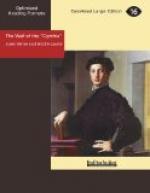“You are now in possession of all the facts as far as I have been able to learn them,” he said. “And you must bear in mind that the extraordinary ability of the child is only a secondary phenomenon, and largely due to the interest with which Mr. Malarius has always regarded him, and of which he has made the best use. It was his unusual acquirements which first drew my attention to him and led me to make inquiries about him. But in reality this has little connection with the questions which now occupy me, which are: where did this child come from, and what course would it be best for me to take in order to discover his family? We have only two facts to guide us in this search. First: The physical indications of the race to which the child belongs. Second: The name ‘Cynthia,’ which was engraved on the buoy.
“As to the first fact, there can be no doubt; the child belongs to the Celtic race. He presents the type of a Celt in all its beauty and purity.
“Let us pass to the second fact:
“‘Cynthia’ is certainly the name of the vessel to which the buoy belonged. This name might have belonged to a German vessel, as well as to an English one; but it was written in the Roman characters. Therefore, the vessel was an English one—or we will say Anglo-Saxon to be more precise. Besides, everything confirms the hypothesis, for more than one English vessel going and coming from Inverness, or the Orkneys, have been driven on the coast of Norway by a tempest; and you must not forget that the little living waif could not have been floating for a long while, since he had resisted hunger, and all the dangers of his perilous journey. Well, now you know all, and what is your conclusion my dear friends?”
Neither the professor nor the lawyer thought it prudent to utter a word.
“You have not been able to arrive at any conclusion,” said the doctor, in a tone which betrayed a secret triumph. “Perhaps you even think there is a contradiction between the two facts—a child of the Celtic race—an English Vessel. But this is simply because you have failed to bear in mind the existence on the coast of Great Britain of a people of the Celtic race, on her sister island, Ireland. I did not think of it at first myself, and it prevented me from solving the problem. But when it occurred to me, I said to myself: the child is Irish. Is this your opinion, Hochstedt?”
If there was anything in the world the professor disliked, it was to give a positive opinion upon any subject. It must also be confessed that to give such an opinion in this case would have been premature. He therefore contented himself with nodding his head, and saying:
“It is an incontestable fact that the Irish belong to the Celtic branch of the Arian race.”
This was a sufficiently safe aphorism, but Doctor Schwaryencrona asked nothing more, and only saw in it the entire confirmation of his theory.




